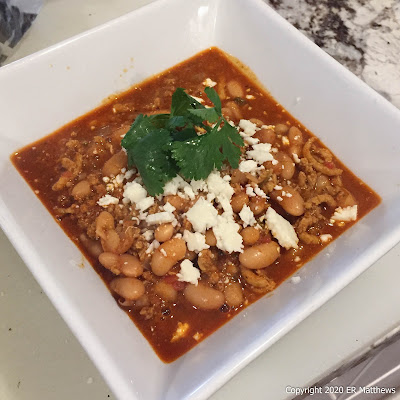As luck would have it, I was in a local store that sells overstock and surplus goods and they had a bunch of peruanos for sale. I bought three kilos clearly packed and labeled for the Mexican market. "Beans" is the only word in English on the entire package.
 |
| A Kilo of Frijoles Peruanos |
When faced with a new bean, I like to do two things with them to check them out. First, I like to cook them as pot beans (frijoles de la olla) and then recook them as refritos, refried beans. The first tells me a lot about how they hold their shape and what their basic flavor is. The second tells me how creamy the bean is.
 |
| Pot Beans, Frijoles de la Olla, Starting to Cook |
After the peruanos soaked overnight in three or four changes of water, I started them in a big pot. I'm afraid I don't have an earthenware olla in which they are traditionally cooked. A lot of people, when cooking frijoles de la olla, merely cook the beans with a little onion, garlic, and a sprig or two of epazote.
I've tried epazote over and over and I just can't become acclimated to its medicinal, creosote-like flavor. So I don't use it. Moreover, I knew that I wanted use my beans for frijoles charros after they cooked, so I jumped the gun a bit and cooked these beans with onion, poblano, garlic, tomatoes, and cilantro stems, rather than just plain with onion or plain with onion and beer (frijoles borrachos, drunken beans).
The beans hold their shape really well and they seem like a versatile general purpose bean. I can see why they are a favorite bean in Jalisco.
 |
| Frijoles a la Charra |
After the beans became tender, I made a pound of chorizo (Numex chile, cumin, Mexican oregano, garlic, black pepper, salt, and red wine vinegar) and fried that up a bit. Then I added several ladles of beans and their broth to the chorizo. After cooking for twenty minutes or so to meld all the flavors, we gobbled up bowls of these soupy beans, topped with a touch of cotija and cilantro.
Most versions of these beans, named after the ranchers and cowboys of the north of Mexico, include bacon, ham, and/or other meats. I didn't want to go whole hog with this batch, preferring to emphasize the beans over the meat. While they constituted the entirety of our dinner, they are usually a side dish to the carne asada at grill fests all over the north of Mexico.
This style of beans is often called cowboy beans in English after the charros, but I prefer to call them a la charra after the cowboy's wife, because who do we really think was cooking the beans while the cowboys were out doing cowboy stuff?
 |
| Enfrijoladas de Pollo |
Because a kilo of beans is a lot of beans for two people, there were plenty of leftover pot beans to play with. The next thing I wanted to do was get a sense for how creamy the beans were. I decided to make a great Mexican dish that you encounter rarely north of the border: enfrijoladas. Think enchiladas using a bean sauce rather than a chile sauce. I outline how to make enfrijoladas in a separate post.
 |
| Antique Bean Masher |
The verdict after scarfing the enfrijoladas is that frijoles peruanos make great refritos. For making refritos, even though I have a beautiful old antique bean masher that I've used a lot, I'm spoiled by my big Vitamix blender. The photo above is of a heavy hand-carved maple masher that feels great in my hand, but takes a lot of effort and time for making big batches of refried beans.
 |
| Frijoles Refritos |
To make refritos, I give the pot beans and plenty of their cooking liquid a quick whir in the blender. Then they go into a hot pan containing lard, or in this case, bacon grease leftover from cooking bacon for BLTs the day before. Sometimes I add finely minced onion to my refritos, but not this time. The beans in the photo above are starting to hold their shape when the spatula moves through them, but they still contain too much liquid. When done, the beans will start to pull away from the edge of the pan.
 |
| Tostadas/Garnaches |
After a couple of lunches of plain beans, I made refritos from the remaining beans, smeared them on tostadas, and topped them with fresh tomato, fresh raw sweet corn, and a touch of cotija. Here in the states, we know tostadas pretty well. In countries other than Mexico such as Guatemala and Belize, tostadas topped with refried beans are known as garnaches, though they're slightly different than what you see above.
Here's a tip for you. I don't buy overpriced tostadas at the store. I also don't fry mine. I sandwich fresh corn tortillas 8 at a time between two half sheet trays and bake them at 350F until they are crisp. Sandwiching them between the two sheet trays keeps them relatively flat.
So ends the tale of this kilo of frijoles peruanos. By whatever name, they're a wonderfully versatile bean that I wish I had the opportunity to try much earlier in my life.




No comments:
Post a Comment